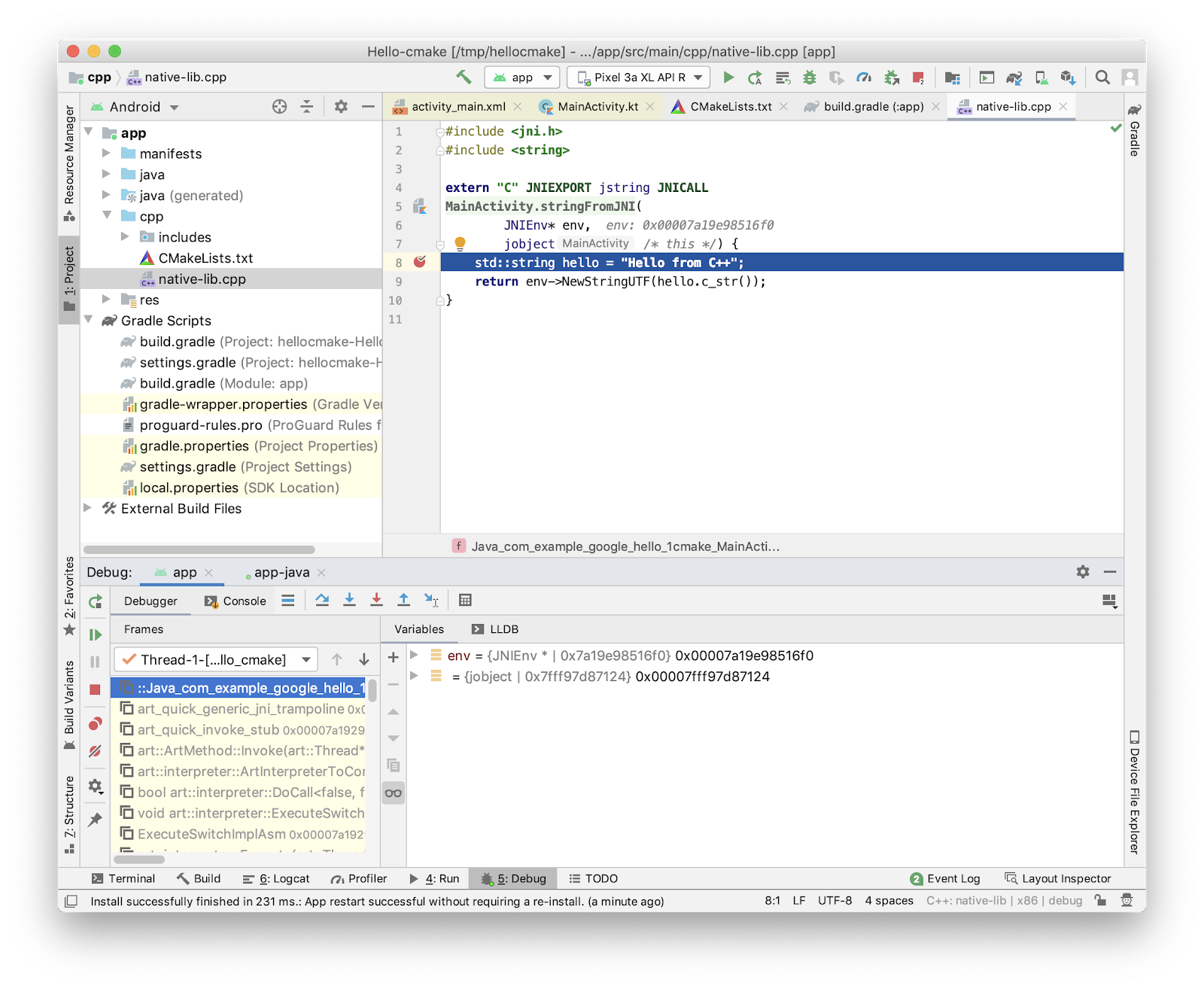- Ndk Build Android Studio For Macbook
- Ndk Build Android Studio For Mac Os
- Ndk Build Android Studio For Mac Os X 10 6 8
- Ndk Build Android Studio For Mac
- Ndk Build Android Studio For Mac Install
Building from Android Studio. From the Welcome screen of Android Studio choose 'Import project' and select the android folder of your app. You should be able to use the Run button to run your app on a device. Android Studio won't start the packager automatically, you'll need to start it by running npm start on the command line. Additional notes. Below are my notes on how to build an Android application by hand from the command line. The instructions are for Linux, but they should be easy to adapt to Mac or Windows. The full source code and a build script is available in commandlineandroid.tar.gz. Table of Contents. Installing the Development Tools; The Hello World Program; Building. Aug 17, 2020 The ndk-build script lives in the top level NDK installation directory. To run it from the command line, invoke it while in or under your application project directory. For example: $ cd $ ndk/ndk-build. In this example, points to your project's root directory, and ndk is the directory where you installed the NDK. To build Skia for Android you need an Android NDK. If you do not have an NDK and have access to CIPD, you can use one of these commands to fetch the NDK our bots use./bin/sk asset download androidndklinux /tmp/ndk./bin/sk asset download androidndkdarwin /tmp/ndk./bin/sk.exe asset download androidndkwindows C:/ndk.
This post falls into the category of 'write it down before I forget it'. I know next to nothing about Android/Java development (approx 12 hours worth) but I knew I needed a certain C++ library for an upcoming app. I managed to get the C++ library working from java after 20+ attempts, 4 coffees and the better part of an evening.
Now that your native code is written and your make file is in place, it's time to compile the native code. From the command line (Windows users, you'll want to do this within Cygwin), you'll need to run the ndk-build command from the root directory of your project. The ndk-build tool is found within the NDK tools directory.
References
Most of the code here is cobbled together from these sources:
- Android Native Development Kit (NDK), and included documentation.
My Setup
Android Studio v0.23, NDK release 9, target SDK version of 8. Mac OS.
Overview
These are the steps:
- Compile your library for Android
- Write the C/C++ wrapper for your library
- Configure gradle to package up your library
- Test from java
1. Compile your library for Android
First, grab the Android Native Development Kit (NDK). This includes a toolchain for cross-compiling C/C++ to Android. Extract the NDK somewhere sane, and add the tools to your path.
The key documentation file to read is called STANDALONE-TOOLCHAIN.HTML as we will be using a standalone toolchain to build the third party library. Install the standard toolchain. The commands below will install it to /tmp/my-android-toolchain.
Set some environment variables so that the configuration and build process will use the right compiler.
Extract your library tarball and start the configuration and building process. It is important to tell your configure script which toolchain to use, as well as specifying a folder (prefix) for the output. Since we are building a static library we will also instruct it to build one.
You should now have a yourLibrary.a file in build/lib and a whole pile of headers in build/include. Create a folder called prebuild in your Android project root folder. (The root folder is one level down from the YourAppNameProject folder and is usually named after your app) Copy the yourLibrary.a file to the prebuild folder and also copy the include folder.
2. Write the C/C++ wrapper for your library
This will depend on which library you are wrapping. Modify one of the following to carry out some simple task using the library you are wrapping. These are derived from the hello-jni sample app in the NDK - check there for more info on how they work. Your wrapper files and the .mk files should be placed in the project_root/jni folder.
Ndk Build Android Studio For Macbook
Next, set up the Android.mk file for your wrapper. This is like a makefile for the ndk-build command that will build your wrapper.
I also needed the following in my Application.mk file:
At this point, you should be able to build your library from the jni folder.
You can check the project_root/libs/armeabi folder for your new library.
3. Configure gradle to package up your library
Ndk Build Android Studio For Mac Os
Android Studio doesn't currently support NDK development so some gradle hacks are required. In a nutshell, the modifications copy and package up the .so file so that it is copied and installed with your app. Check the references for more detail. In build.gradle add the following:
Ndk Build Android Studio For Mac Os X 10 6 8
(Update August 2015 - I've been informed that tasks.withType(Compile) should now be tasks.withType(JavaCompile).)
Also add the following to the dependencies{..} section:
4. Test from java
In the activity you are calling your wrapper from, add the following, modifying names as appropriate: Hp keyboard not working desktop.
Ndk Build Android Studio For Mac

Ndk Build Android Studio For Mac Install
If it doesn't crash, you have probably done it. Time to celebrate!

